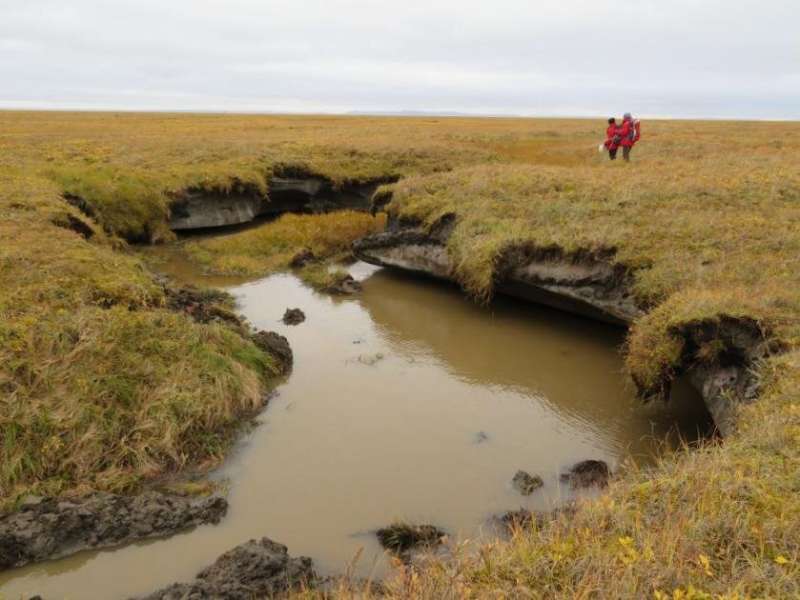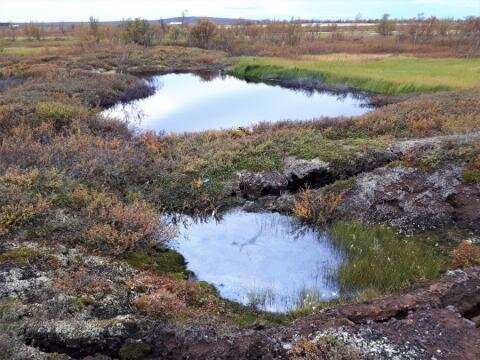Permafrost in the Arctic can thaw faster than presumed

Melting of ice in permafrost ground leads to processes of change in the landscape—thermokarst. This may cause faster thawing of the permafrost.
Some of the coldest permafrost on Earth might be more vulnerable to thawing than previously thought. In the PERMANOR project led by the University of Oslo in Norway, an international research team has investigated so-called thermokarst processes which can significantly accelerate thawing of permafrost. The study is recently published in Nature Communications.
Reinforces warming
Air temperatures are increasing in high latitudes and in high mountain areas dominated by permafrost in the ground. When this permafrost thaws, large amounts of greenhouse gases can be released to the atmosphere, which can potentially intensify global warming.
Another consequence is that ice layers in the ground start to melt, so that the ground subsides and depressions with ponds and lakes form. This landscape change, which is known as "thermokarst", can once again accelerate permafrost thawing in a positive feedback to global warming.
Changes the landscape
The research team from Germany and Norway has developed computer models to investigate how thermokarst processes affect the future of permafrost in Northeastern Siberia. Today this region is dominated by very cold and supposedly stable permafrost.
So far, thermokarst processes have not been included in models that simulate the permafrost evolution in a warming climate. "We found that when including thermokarst processes in our simulations, even cold permafrost in Northern Siberia could thaw at the end of this century, although the ground currently still has temperatures of minus ten degrees" says lead author Jan Nitzbon from the Alfred Wegener Institute for Polar and Marine Research in Germany.

Among scientists, the general assumption is that thermokarst processes locally lead to faster thawing of permafrost.
"However, with our model, we have also considered stabilizing processes that can slow down thawing. We were amazed that under a moderate warming scenario, thermokarst processes can even limit the thawing of permafrost", he states to Titan.uio.no.
Under a stronger warming scenario, however, self-reinforcing processes dominated, which would drastically change these landscapes due to accelerated permafrost thaw.
Also applies to permafrost in Northern Norway
Sebastian Westermann, Associate Professor from the University of Oslo who has led the PERMANOR project, adds:
"Thermokarst not only affects permafrost regions in Siberia, we see the same processes in Norway, especially in peatlands in Finnmark. Within just a few years, new ponds have formed in our study areas, decreasing the permafrost area. In Norway, the permafrost is already now close to the freezing point, and we are observing many of the landscape changes that could occur in Siberia in the future."
Improves global climate model
The researchers have now started to implement the new simulation tools in Earth System Models, such as the Norwegian climate model NorESM. With this, it will be possible to improve future simulations of permafrost thaw not only in Siberia, but on the global scale.
The results of the present study strongly suggest that limiting global warming can help protect arctic ecosystems and landscapes from drastic changes due to thawing of ice-rich permafrost.
More information: Jan Nitzbon et al. Fast response of cold ice-rich permafrost in northeast Siberia to a warming climate, Nature Communications (2020). DOI: 10.1038/s41467-020-15725-8
Journal information: Nature Communications
Provided by University of Oslo


















